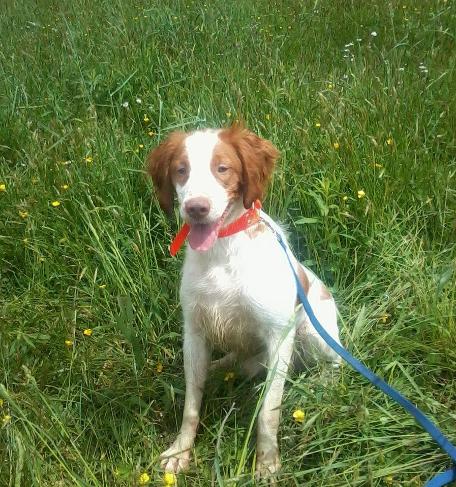
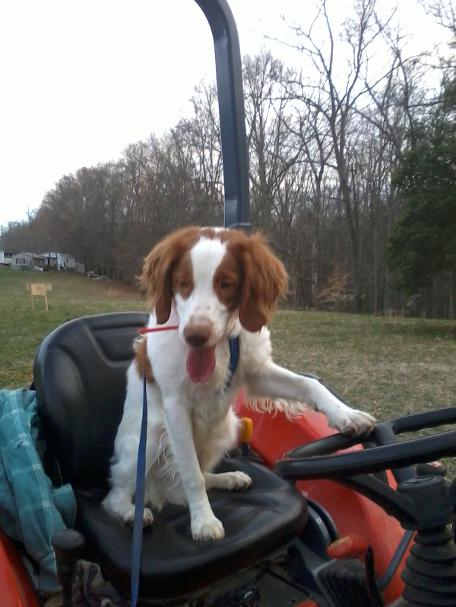
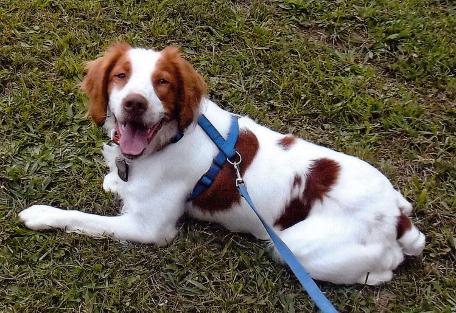
CALL NAME - CHANCE
SEX - MALE
DATE OF BIRTH 08/14/12
BREED - BRITTANY
COLOR - WHITE & ORANGE
EYES - COOPER/GREEN
WEIGHT - 45.4
REGISTRATION - AKC
BREEDER - STEVE COLWELL
SIRE - JUST SAY BEAU
DAM - MISSY LU DEERE
OWNER - DEANNA WARBURTON
WE WOULD LIKE TO WELCOME OUR NEWEST MEMBER OF OUR FAMILY CHANCE OUR MALE BRITTANY WE GOT FOR OUR SON HE JUST ARRIVED HERE ON WED JAN 19TH 2013 HE IS A VERY BEAUTIFUL WHITE & ORANGE WITH COOPER/GREEN EYES HE IS AKC REG. HIS BREEDER IS STEVE COLWELL FROM STANTON KY.
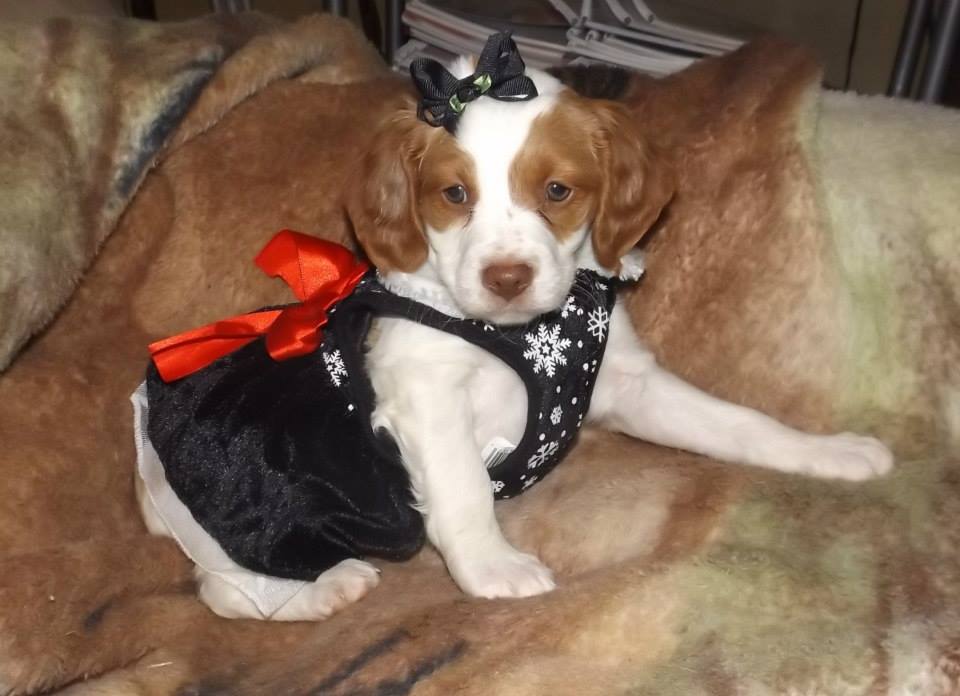
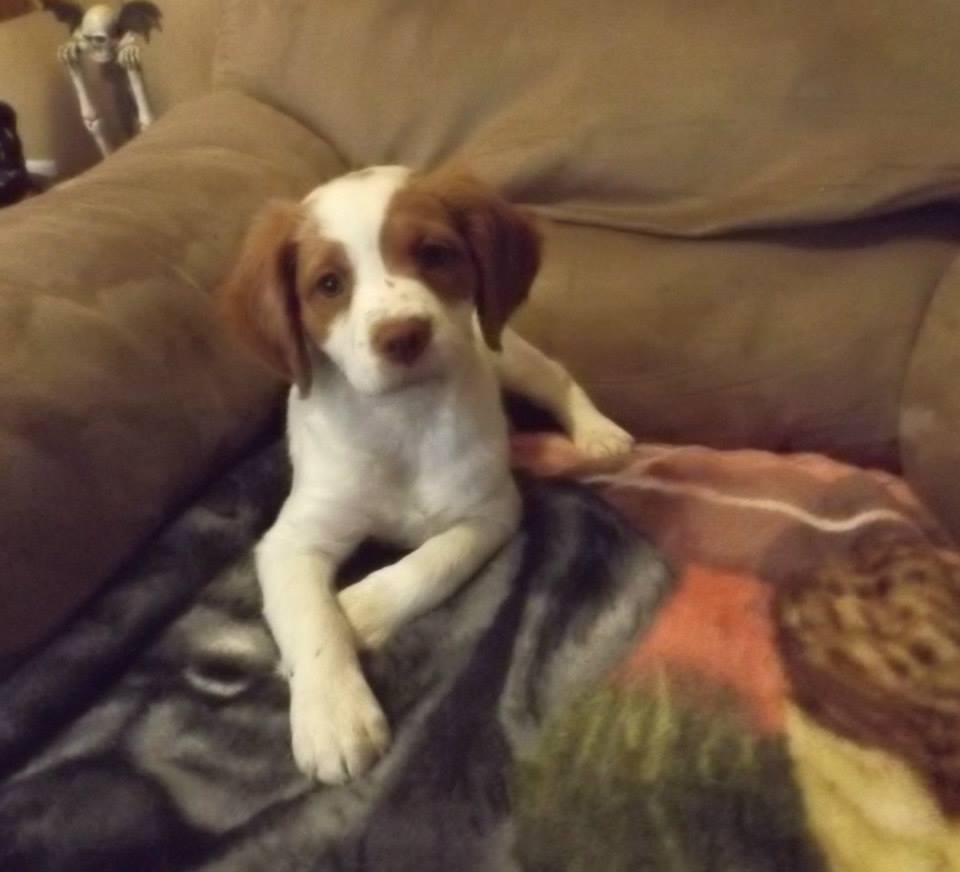
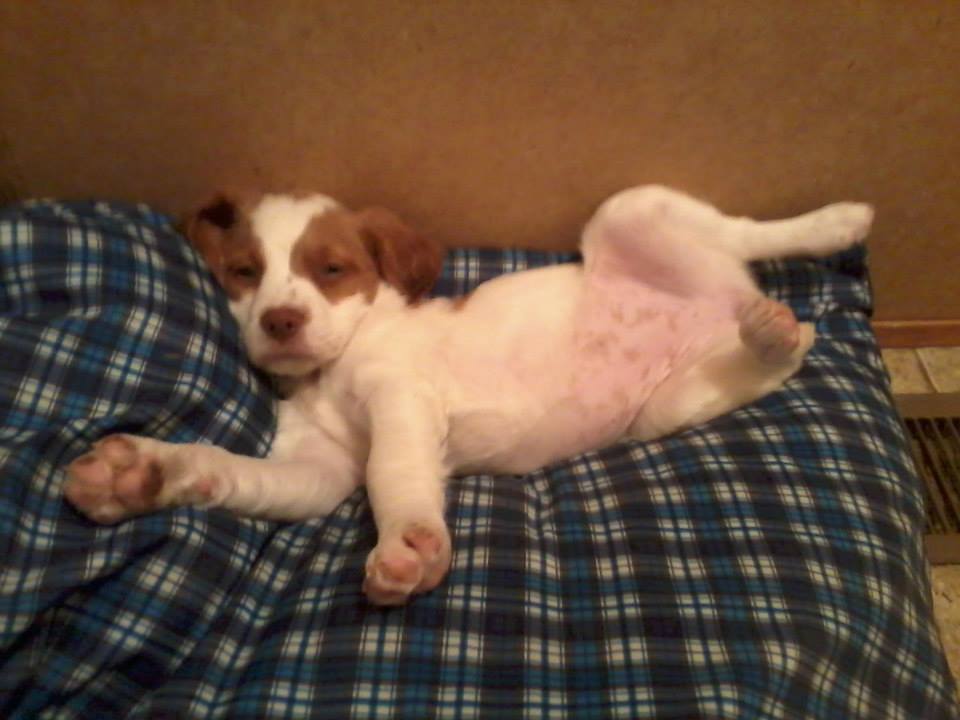
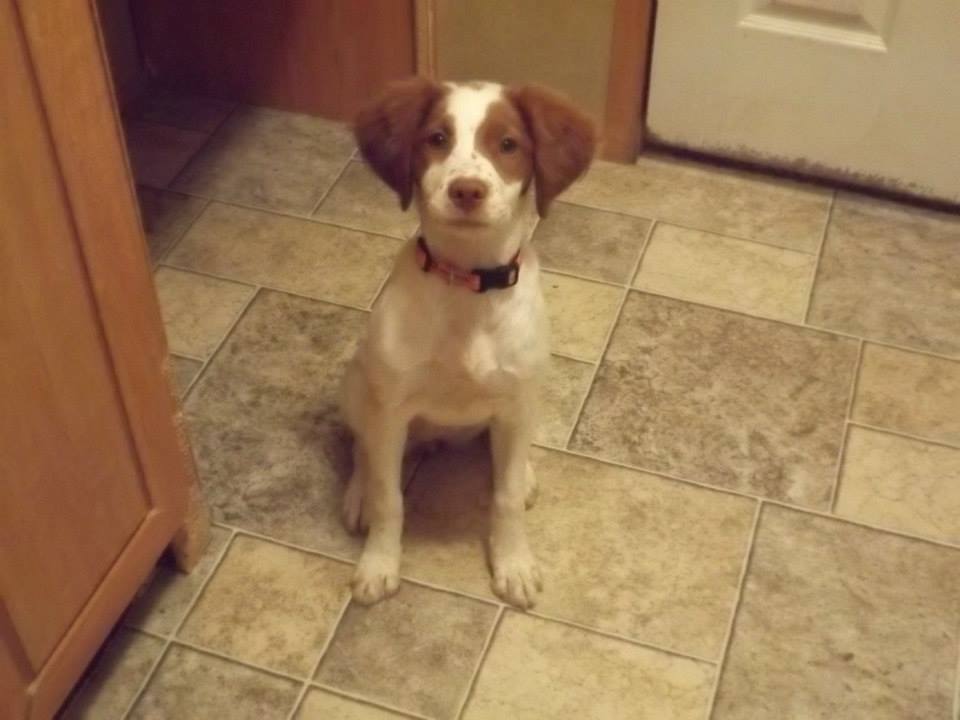
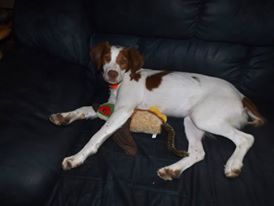
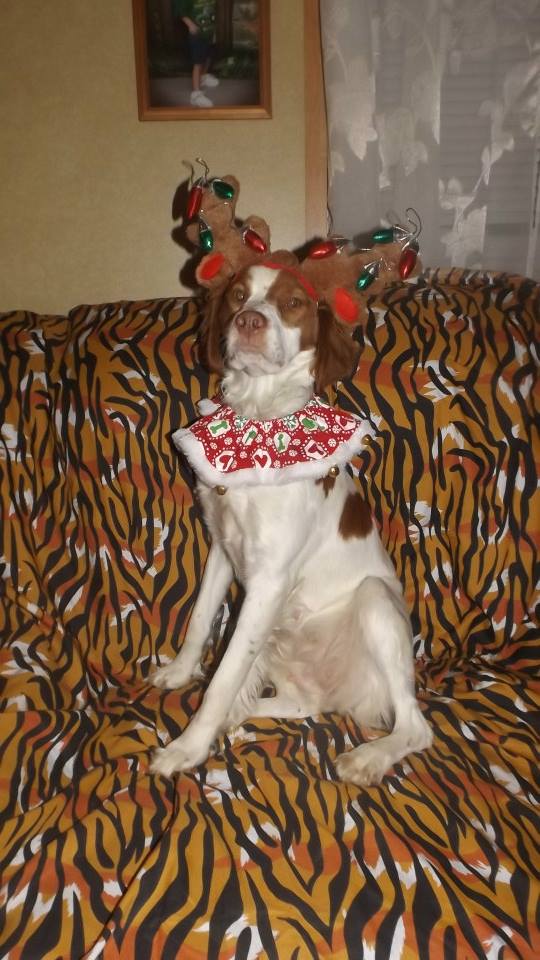
NAME - FRECKLES MY STAR CALL NAME - FRECKLES SEX - FEMALE DATE OF BIRTH - 11/24/13 BREED - BRITTANY COLOR - WHITE & ORANGE EYES - GREENISH WEIGHT - 32.7 LBS REGISTRATION - AKC BREEDER - WADE COMPTON SIRE - HI KNOB MAGIC JET DAM - HIGH KNOB HOPE OWNER - DEANNA WARBURTON
WE WOULD LIKE TO WELCOME OUR NEWEST MEMBER OF OUR FAMILY FRECKLES OUR
FEMALE BRITTANY PUPPY WE GOT FOR OUR SON SHE JUST ARRIVED HERE ON
SATURDAY JAN 11TH 2014 SHE IS A VERY BEAUTIFUL WHITE & ORANGE WITH
COPPER/GREEN EYES SHE IS AKC REG HER BREEDER IS WADE COMPTON FROM
HANSONVILLE VA SHE HAS ALOT OF CHAMPIONS IN HER BLOODLINE
AKC MEET THE BREEDS®
Get to know the Brittany
Sporting Group
Get to know the Brittany
The Brittany is a medium-sized, leggy, dual-purpose dog, equally suited for sport and companionship. According to AKC® Registration Statistics, it has surged in popularity in the last 50 years due to its talents as both a hunting and show dog. Originally called the Brittany Spaniel, it is now referred to simply as the Brittany, as its hunting style more closely resembles that of pointing breeds. Its dense, flat or wavy coat can be orange and white or liver and white in either clear or roan patterns.
A Look Back
The Brittany was named for the French province where it originated, but
records of its development are largely lost. There is a great deal of
resemblance between the Brittany and Welsh Springer Spaniel, which
leads many people to believe that the two breeds share the same
ancestors. It is possible that native Brittany spaniels mated with
English pointing dogs around 1900, intensifying their hunting prowess
in the process.
Breed Standard
General Appearance
A compact, closely knit dog of medium size, a leggy dog having the
appearance, as well as the agility, of a great ground coverer. Strong, vigorous,
energetic and quick of movement. Ruggedness, without clumsiness, is a characteristic
of the breed. He can be tailless or has a tail docked to approximately four inches.
Size, Proportion, Substance
Height--17½ to 20½ inches, measured from the ground
to the highest point of the shoulders. Any Brittany measuring under 17½
inches or over 20½ inches shall be disqualified from dog show competition. Weight--Should weigh between 30 and 40 pounds. Proportion--So leggy is he that his height at the shoulders
is the same as the length of his body. Body Length--Approximately the same as the height when measured
at the shoulders. Body length is measured from the point of the forechest to the
rear of the rump. A long body should be heavily penalized. Substance--Not too light in bone, yet never heavy-boned and cumbersome.
Head
Expression--Alert and eager, but with the soft expression of a bird
dog. Eyes--Well set in head. Well protected from briars by a heavy, expressive
eyebrow. A prominent full or popeye should be penalized. It is a serious fault
in a dog that must face briars. Skull well chiseled under the eyes, so that the
lower lid is not pulled back to form a pocket or haw that would catch seeds, dirt
and weed dust. Preference should be for the darker colored eyes, though lighter
shades of amber should not be penalized. Light and mean-looking eyes should be
heavily penalized. Ears--Set high, above the level of the eyes. Short and triangular,
rather than pendulous, reaching about half the length of the muzzle. Should lie
flat and close to the head, with dense, but relatively short hair, and with little
fringe. Skull--Medium length, rounded, very slightly wedge-shaped, but evenly
made. Width, not quite as wide as the length and never so broad as to appear coarse,
or so narrow as to appear racy. Well defined, but gently sloping stop. Median
line rather indistinct. The occiput only apparent to the touch. Lateral walls
well rounded. The Brittany should never be "apple-headed" and he should never
have an indented stop. Muzzle--Medium length, about two thirds the length of the skull,
measuring the muzzle from the tip to the stop, and the skull from the occiput
to the stop. Muzzle should taper gradually in both horizontal and vertical dimensions
as it approaches the nostrils. Neither a Roman nose nor a dish-face is desirable.
Never broad, heavy or snippy. Nose--Nostrils well open to permit deep breathing of air and adequate
scenting. Tight nostrils should be penalized. Never shiny. Color: fawn, tan, shades
of brown or deep pink. A black nose is a disqualification. A two-tone or butterfly
nose should be penalized. Lips--Tight, the upper lip overlapping the lower jaw just to cover
the lower lip. Lips dry, so that feathers will not stick. Drooling to be heavily
penalized. Flews to be penalized. Bite--A true scissors bite. Overshot or undershot jaw to be heavily
penalized.
Neck, Topline, Body
Neck--Medium length. Free from throatiness, though not a serious
fault unless accompanied by dewlaps, strong without giving the impression of being
over muscled. Well set into sloping shoulders. Never concave or ewe-necked. Topline--Slight slope from the highest point of the shoulders to
the root of the tail. Chest--Deep, reaching the level of the elbow. Neither so wide nor
so rounded as to disturb the placement of the shoulders and elbows. Ribs well
sprung. Adequate heart room provided by depth as well as width. Narrow or slab-sided
chests are a fault. Back--Short and straight. Never hollow, saddle, sway or roach backed.
Slight drop from the hips to the root of the tail. Flanks--Rounded. Fairly full. Not extremely tucked up, or flabby
and falling. Loins short and strong. Distance from last rib to upper thigh short,
about three to four finger widths. Narrow and weak loins are a fault. In motion,
the loin should not sway sideways, giving a zig-zag motion to the back, wasting
energy. Tail--Tailless to approximately four inches, natural or docked.
The tail not to be so long as to affect the overall balance of the dog. Set on
high, actually an extension of the spine at about the same level. Any tail substantially
more than four inches shall be severely penalized.
Forequarters
Shoulders--Shoulder blades should not protrude too much, not too
wide apart, with perhaps two thumbs' width between. Sloping and muscular. Blade
and upper arm should form nearly a ninety degree angle. Straight shoulders are
a fault. At the shoulders, the Brittany is slightly higher than at the rump. Front Legs--Viewed from the front, perpendicular, but not set too
wide. Elbows and feet turning neither in nor out. Pasterns slightly sloped. Down
in pasterns is a serious fault. Leg bones clean, graceful, but not too fine. Extremely
heavy bone is as much a fault as spindly legs. One must look for substance and
suppleness. Height at elbows should approximately equal distance from elbow to
withers. Feet--Should be strong, proportionately smaller than the spaniels',
with close fitting, well arched toes and thick pads. The Brittany is "not up on
his toes." Toes not heavily feathered. Flat feet, splayed feet, paper feet, etc.,
are to be heavily penalized. An ideal foot is halfway between the hare and the
cat foot. Dewclaws may be removed.
Hindquarter
Broad strong and muscular, with powerful thighs and well bent stifles, giving
the angulation necessary for powerful drive. Hind Legs--Stifles well bent. The stifle should not be so angulated
as to place the hock joint far out behind the dog. A Brittany should not be condemned
for straight stifle until the judge has checked the dog in motion from the side.
The stifle joint should not turn out making a cowhock. Thighs well feathered but
not profusely, halfway to the hock. Hocks, that is, the back pasterns, should
be moderately short, pointing neither in nor out, perpendicular when viewed from
the side. They should be firm when shaken by the judge. Feet Same as front feet.
Coat
Dense, flat or wavy, never curly. Texture neither wiry nor silky. Ears should
carry little fringe. The front and hind legs should have some feathering, but
too little is definitely preferable to too much. Dogs with long or profuse feathering
or furnishings shall be so severely penalized as to effectively eliminate them
from competition. Skin--Fine and fairly loose. A loose skin rolls with briars and
sticks, thus diminishing punctures or tearing. A skin so loose as to form pouches
is undesirable.
Color
Orange and white or liver and white in either clear or roan patterns. Some ticking
is desirable. The orange or liver is found in the standard parti-color or piebald
patterns. Washed out colors are not desirable. Tri-colors are allowed but not
preferred. A tri-color is a liver and white dog with classic orange markings on
eyebrows, muzzle and cheeks, inside the ears and under the tail, freckles on the
lower legs are orange. Anything exceeding the limits of these markings shall be
severely penalized. Black is a disqualification.
Gait
When at a trot the Brittany's hind foot should step into or beyond the print left
by the front foot. Clean movement, coming and going, is very important, but most
important is side gait, which is smooth, efficient and ground covering.
Temperament
A happy, alert dog, neither mean nor shy.
Disqualifications
Any Brittany measuring under 17½ inches or over 20½ inches
A black nose
Black in the coat
Country of Origin: The Brittany (also known as the ‘American Brittany’, ‘Brittany Spaniel’, and ‘Epagneul Breton’) originated in the Brittany province of France in the 1800’s from crosses of the English Setter and small Spaniels. It is a skilled bird hunter with excellent scenting abilities. The Brittany’s pointing and retrieving skills and high level of obedience made it popular among hunters, particularly poachers. Brittanys were first imported to North America in the 1920’s and recognized by the American Kennel Club in 1934 (the registered name was changed from ‘Brittany Spaniel’ to ‘Brittany’ in 1982, out of recognition of its more ‘setter’-like hunting style), but took a while to catch on popularity due to the absence of a long tail. The Brittany has slowly risen in popularity due to its small size, easygoing personality, and excellent hunting skills. It is today the most popular pointer in field trials.
Size: The Brittany has a shoulder height of 43-53 cm (17-21 in) and weighs 14-18 kg (30-40 lbs). It has a brown or pink nose, small, highly set, triangular ears, and an alert expression. Brittanys are compact and muscular with long legs and naturally short or cropped tails up to 10 cm (4 in) in length. They are approximately as long as they are tall. Some breeders distinguish between ‘American Brittanys’, which are taller and faster for the wide American plains, and ‘French Brittanys’, which are more similar to Spaniels.
Coat: The Brittany has a medium length, dense, flat or wavy coat with feathering on the legs. The most common color is white with orange markings. Other colors for Brittanys are white and liver, white and black, liver tricolored and black tricolored. Any pattern may be solid or roan with ticking. Some registries allow black Brittanys.
Character: The Brittany is athletic, intelligent, quick and curious. It is a kind, adventurous breed which shows a large measure of independence. If not sufficiently exercised, the Brittany will become destructive.
Temperament: The Brittany gets along well with children, but should be monitored around small children due to its high energy level. The Brittany gets along well with other dogs and pets; Brittanys are recommended for homes of at least two dogs so they have a companion for play at all times. They are kind to strangers, which makes them a poor choice for personal protection.
Care: The Brittany requires little maintenance; only weekly grooming with a brush is required. The Brittany has a lifespan of 12-13 years. It is a generally healthy breed, but susceptible to some common canine maladies such as hip dysplasia (malformed hip joint which can cause lameness or arthritis), epilepsy, and ear infection.
Training: The Brittany has a well deserved reputation for being easy to train due to its intelligence and obedience. It has a strong desire to please its master and is usually ready to accept direction. Brittanys are highly sensitive; any discipline beyond a harsh word or stern look is strongly discouraged and unlikely to prove beneficial.
Activity: The Brittany requires an hour or more of serious exertion every day. It is not sufficient to take the Brittany for walks, which makes it unsuitable for apartment life. The Brittany is happiest living where it can run freely and take part in field sports.
Brittany's are intelligent, sensitive, non-confrontational, gentle
yet very energetic, and are often referred to as having a soft
disposition.
Brittany's require plenty of daily exercise in a safe area. They
love to run, play, and generally just hang out with you. They
thrive on attention and love. They are never mean nor vicious
as this is NOT characteristic of the breed.
Brittany's smaller size (30 to 40 pounds) and personality make
them a true dual purpose dog for families. They make great
family pets and wonderful hunting dogs thus they are one of the
most popular choices for families with kids and a hunter. Most
families allow their Brittany in their home. We feel that
Brittany's who are made an integral part of the family perform
better in the field.
They do not thrive living life in a kennel or being cooped up
all day. They will chew and dig when bored so lots of chew
toys and free space are essential. They can be mischievous
if left alone in the home so crate training is a great idea
(we recommend it). They may dig and chew when bored
(see Brittany FAQ's page)
Our
Brittany's hail from great, proven, hunting dogs as well as companion
dogs. We enjoy them as indoor pets, outdoor exercise partners (daily),
and of course, good hunting buddies.
It is best to not try to
replicate a wonderfully informational web page about Brittany
height/weight standards, therefore, we invite you to visit the AKC
website for all of the Brittany conformation standards and such. (Very
good site)...Come right back to enjoy our recipes and other free and
neat Brittany stuff.
Breed Group: Sporting
Weight: 30-40 lbs
Height: 17.5-20.5 inches
Color(s): orange and white, liver and white, or tricolored
Overview
An
intelligent breed, this dog does well in hunting sports. A gentle breed
that is very obedience and very eager to please. Alert, lively, and
independent, this breed is overall good-natured. The Brittany Spaniel is
generally good with children and other pets if socialized properly
throughout puppyhood.
Character
The Brittany Spaniel loves
water. Described as a very friendly and loyal companion, this dog also
does well in a country environment. Originally bred for hunting, this
breed has natural protective instincts. This breed is considered a very
popular companion dog.
Temperament
Happy and alert, this
breed has a great presence. Easy to handle, and affectionate, this breed
would make an ideal house pet if given the right care and exercise to
keep him happy. This breed requires a gentle, yet somewhat firm hand, as
they can be hyperactive.
Care
A relatively light shedding
breed, this dog does require regular brushing to keep coat from
becoming matted. Bathing once a month is recommended. Some trimming is
necessary if to be used for show.
Coat
Silky, feathered
beautiful coat is medium length and does not require much maintenance.
Colors accepted are Orange and White, Liver and White, Black and White,
Liver tri-color, and Black Tri-color.
Training
As this
breed is rather hyperactive, they can become bored easily. Consistent
training and a firm hand is recommended to keep you and your spaniel
happy. This free thinking breed responds well in hunting or retrieving
sports and is easy to train.
Activity
A medium sized yard
is a must for this rambunctious breed. This breed has plenty of stamina
to keep you on your toes and does require regular exercise. Would do
best in a home with at least a medium sized yard, and an active owner.
Ownership
If
you are looking for Brittany (Better Known As The Brittany Spaniel)
puppies for sale from reputable Brittany breeders or to adopt Brittany
from a Brittany rescue then make sure you understand as much about the
dog breeds you are interested in as you can. Every puppy breed is
different. Begin your research by reading the breed information about
the Brittany puppy above. Search our dog breeds section to find Brittany
puppies that make great pets.
Country of Origin: The Yorkshire Terrier (or ‘Yorkie’) was bred in Yorkshire, Northern England in the 1800’s to hunt and kill rats and other vermin. It was carefully bred from a number of working terriers, some of which came to England alongside Scottish immigrants looking for factory work. The Yorkshire Terrier may have derived its long coat and blue coloring from the Clydesdale and Skye Terriers, and its signature coat pattern likely results from crosses with the English Black and Tan Terrier. Early Yorkshire Terriers were known as Broken-Haired Scotch Terriers or Toy Terriers. Huddersfield Ben, born in Yorkshire in 1865, was a popular champion and skilled ratter who sired many small Yorkshire Terriers and is today universally recognized as the patriarch of the breed. The Yorkshire Terrier was imported to America in 1872 and recognized by the American Kennel Club in 1878. The Yorkshire Terrier became the American Kennel Club’s second most registered dog in 2006 at 48,000 registrations, beat out only by the Labrador Retriever. Famous Yorkshire Terriers include Audrey Hepburn’s Yorkie ‘Mr. Famous’ who appeared with her in ‘Funny Face’ and Tricia Nixon’s pet Yorkie ‘Pasha’. ‘Toto’ from ‘The Wizard of Oz’ was played by a Cairn Terrier in the film but originally illustrated as a Yorkshire Terrier in the novel. Some Yorkies are famous for their small size, such as Big Boss, Guinness World Record holder in 2002 for smallest living dog at 12 cm (5 in) tall, and Sylvia, a Yorkshire Terrier from England who was the smallest dog in recorded history at 2.5 inches tall and weighed merely 4 ounces!
Size: The Yorkshire Terrier is 20-23 cm (8-9 in) tall and weighs 2-3 kg (4-7 lbs). Yorkshire Terriers have a small, flat head, level or scissors bite, dark, intelligent eyes, and small, highly set, ‘V’-shaped ears. They have a flat back, round ears, and tail carried high.
Coat: The Yorkshire Terrier has a very long, straight, silky coat which is golden-brown at the head, chest, and legs. The color and texture of the coat are perhaps the most important show trait. Puppy Yorkshire Terriers are born black and tan and gradually attain their natural color. Show dogs are groomed with the hair grown out long (sometimes trimmed to floor-length) and parted down the middle of the back. Yorkies have no undercoat and shed little.
Character: Yorkshire Terriers become attached to their families, but most maintain some measure of independence. They have a boisterous Terrier personality that far exceeds their small size. Yorkies are lively, bold, and intelligent (scoring in the top third in dog intelligence tests). They bark when they sense danger. Due to their strong ‘alpha-dog’ personality, the Yorkshire Terrier may not be suitable for inexperienced owners.
Temperament: The Yorkshire Terrier is tolerant of older children, provided they respect its personal space. Due to its small size and bold temperament (which arises from its working origins) the Yorkshire Terrier is not recommended for young children unless carefully supervised. The Yorkshire Terrier can occasionally be a bit too brave when dealing with larger dogs, but gets along fine with cats and other household pets. Yorkies prefer life indoors, and are especially unsuited to cold climates.
Care: The Yorkshire Terrier requires intensive brushing and combing on a daily basis. If this is too time-consuming, the coat should be trimmed professionally. The Yorkie’s hair should be kept out of its eyes by a rubber band or a bow. Loose hairs should be regularly removed from ear passages. Yorkshire Terriers have a lifespan of 12-15 years. Yorkie puppies are prone to hypoglycemia (diagnosed by listless behavior and shakiness) and adults are prone to a number of musculoskeletal issues and distichia (extra eyelashes on the eyelid which can scratch the cornea if not properly treated). Yorkies under 3 pounds are especially susceptible to diarrhea, vomiting, tracheal collapse, anesthesia sensitivity, and injury.
Training: The Yorkshire Terrier is intelligent and capable of learning quickly with consistent training, but some prolong the process with their independent, stubborn nature. The Yorkshire Terrier is considered to be one of the more difficult breeds to housebreak.
Activity: The Yorkshire Terrier can have most of its needs met through indoor play, but still prefers a daily walk or romp in a fenced-in yard. Yorkshire Terriers are well suited to apartment life.
haired toy terrier whose blue and tan coat is parted on the face and from the base of the skull to the end of the tail and hangs evenly and quite straight down each side of body. The body is neat, compact and well proportioned. The dog's high head carriage and confident manner should give the appearance of vigor and self importance. Head Small and rather flat on top, the skull not too prominent or round, the muzzle not too long, with the bite neither undershot nor overshot and teeth sound. Either scissors bite or level bite is acceptable. The nose is black. Eyes are medium in size and not too prominent; dark in color and sparkling with a sharp, intelligent expression. Eye rims are dark. Ears are small, V shaped, carried erect and set not too far apart. Body Well proportioned and very compact. The back is rather short, the back line level, with height at shoulder the same as at the rump. Legs and Feet Forelegs should be straight, elbows neither in nor out. Hind legs straight when viewed from behind, but stifles are moderately bent when viewed from the sides. Feet are round with black toenails. Dewclaws, if any, are generally removed from the hind legs. Dewclaws on the forelegs may be removed. Tail Docked to a medium length and carried slightly higher than the level of the back. Coat Quality, texture and quantity of coat are of prime importance. Hair is glossy, fine and silky in texture. Coat on the body is moderately long and perfectly straight (not wavy). It may be trimmed to floor length to give ease of movement and a neater appearance, if desired. The fall on the head is long, tied with one bow in center of head or parted in the middle and tied with two bows. Hair on muzzle is very long. Hair should be trimmed short on tips of ears and may be trimmed on feet to give them a neat appearance. Colors Puppies are born black and tan and are normally darker in body color, showing an intermingling of black hair in the tan until they are matured. Color of hair on body and richness of tan on head and legs are of prime importance in adult dogs, to which the following color requirements apply Blue Is a dark steel blue, not a silver blue and not mingled with fawn, bronzy or black hairs. Tan All tan hair is darker at the roots than in the middle, shading to still lighter tan at the tips. There should be no sooty or black hair intermingled with any of the tan. Color on Body The blue extends over the body from back of neck to root of tail. Hair on tail is a darker blue, especially at end of tail. Head fall A rich golden tan, deeper in color at sides of head, at ear roots and on the muzzle, with ears a deep rich tan. Tan color should not extend down on back of neck. Chest and Legs A bright, rich tan, not extending above the elbow on the forelegs nor above the stifle on the hind legs. Weight Must not exceed seven pounds. Disqualifications Any solid color or combination of colors other than blue and tan as described above. Any white markings other than a small white spot on the forechest that does not exceed 1 inch at its longest dimension. Approved July 10, 2007 Effective October 1, 2007
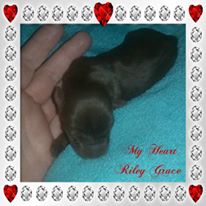
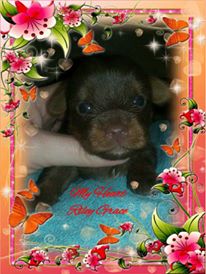
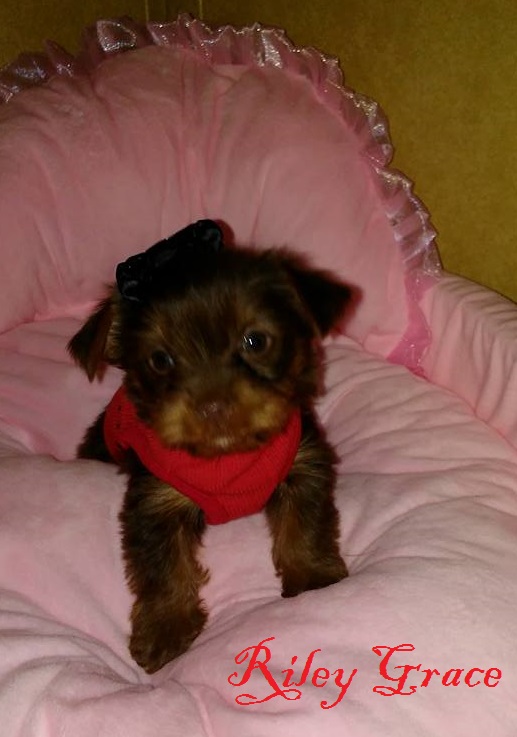
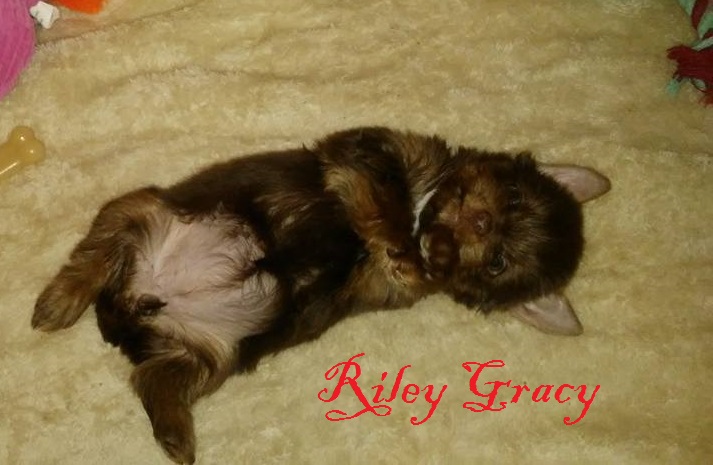
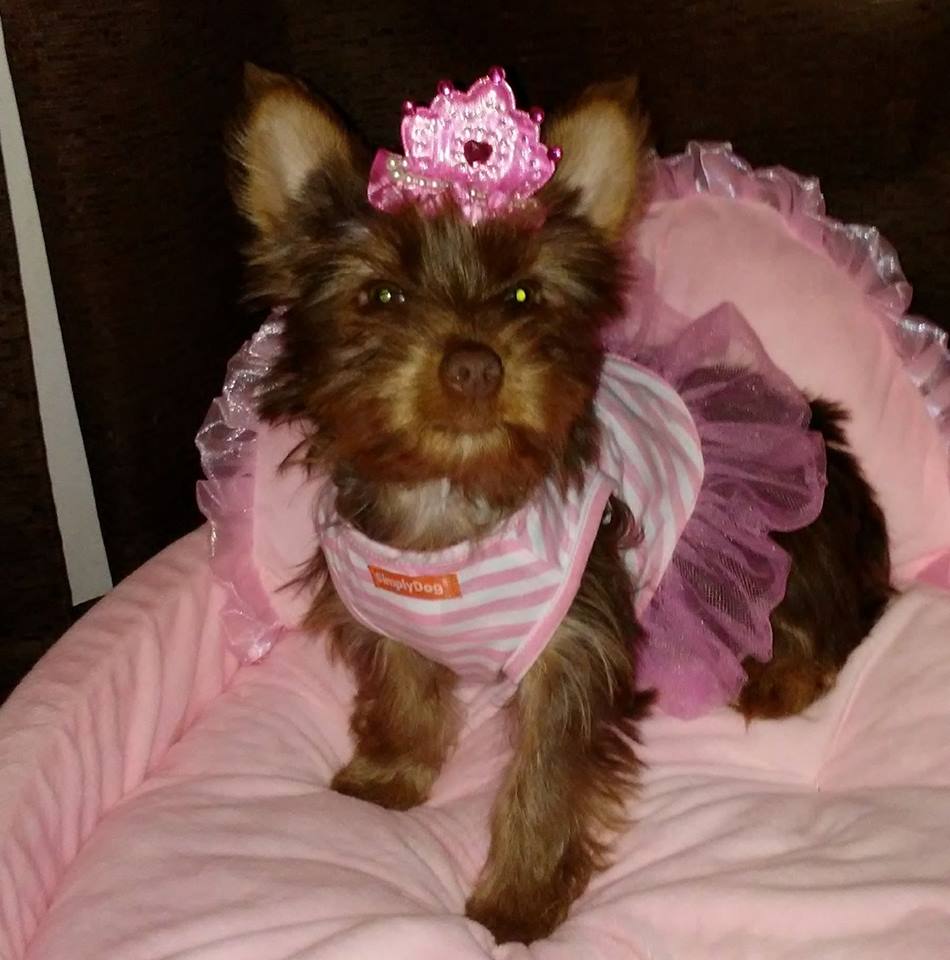
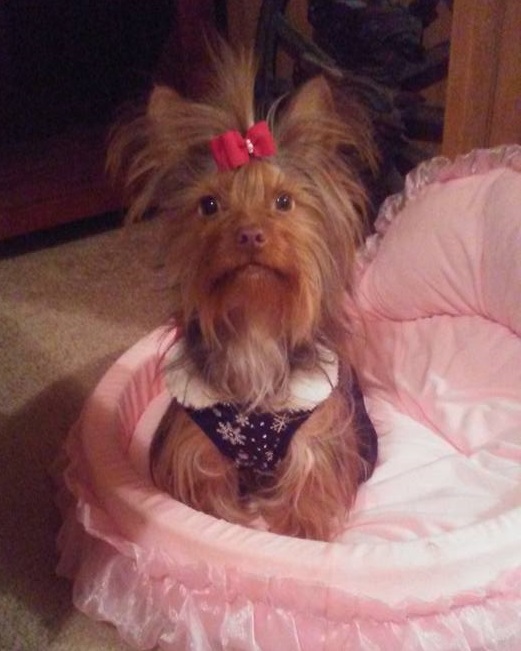
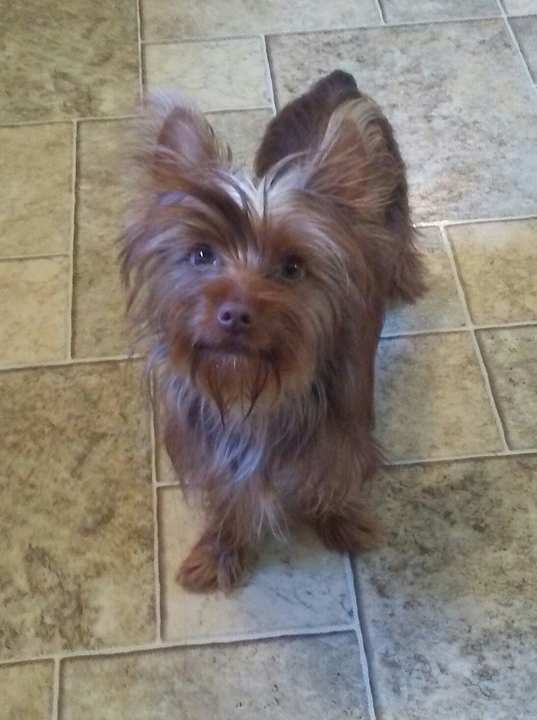
CALL NAME - RILEY
SEX - FEMALE
DATE OF BIRTH - 02/02/17
BREED - YORKSHIRE TERRIER
COLOR - CHOCOLATE
EYES - GREENISH
WEIGHT - 7LBS
REGISTRATION - CKC
BREEDER - CHRISTENNA DAVIS
SIRE - TUCKER
DAM - LUCY
OWNER - DEANNA WARBURTON
WE WOULD LIKE TO WELCOME OUR NEWEST MEMBER OF OUR FAMILY RILEY OUR FEMALE YORKIE THIS LITTLE GIRL IS MY HEART SHE IS PERFECT IN EVERY WAY AND SHE WILL NOT BE BRED
Country of Origin: The Yorkshire Terrier (or ‘Yorkie’) was bred in Yorkshire, Northern England in the 1800’s to hunt and kill rats and other vermin. It was carefully bred from a number of working terriers, some of which came to England alongside Scottish immigrants looking for factory work. The Yorkshire Terrier may have derived its long coat and blue coloring from the Clydesdale and Skye Terriers, and its signature coat pattern likely results from crosses with the English Black and Tan Terrier. Early Yorkshire Terriers were known as Broken-Haired Scotch Terriers or Toy Terriers. Huddersfield Ben, born in Yorkshire in 1865, was a popular champion and skilled ratter who sired many small Yorkshire Terriers and is today universally recognized as the patriarch of the breed. The Yorkshire Terrier was imported to America in 1872 and recognized by the American Kennel Club in 1878. The Yorkshire Terrier became the American Kennel Club’s second most registered dog in 2006 at 48,000 registrations, beat out only by the Labrador Retriever. Famous Yorkshire Terriers include Audrey Hepburn’s Yorkie ‘Mr. Famous’ who appeared with her in ‘Funny Face’ and Tricia Nixon’s pet Yorkie ‘Pasha’. ‘Toto’ from ‘The Wizard of Oz’ was played by a Cairn Terrier in the film but originally illustrated as a Yorkshire Terrier in the novel. Some Yorkies are famous for their small size, such as Big Boss, Guinness World Record holder in 2002 for smallest living dog at 12 cm (5 in) tall, and Sylvia, a Yorkshire Terrier from England who was the smallest dog in recorded history at 2.5 inches tall and weighed merely 4 ounces!
Size: The Yorkshire Terrier is 20-23 cm (8-9 in) tall and weighs 2-3 kg (4-7 lbs). Yorkshire Terriers have a small, flat head, level or scissors bite, dark, intelligent eyes, and small, highly set, ‘V’-shaped ears. They have a flat back, round ears, and tail carried high.
Coat: The Yorkshire Terrier has a very long, straight, silky coat which is golden-brown at the head, chest, and legs. The color and texture of the coat are perhaps the most important show trait. Puppy Yorkshire Terriers are born black and tan and gradually attain their natural color. Show dogs are groomed with the hair grown out long (sometimes trimmed to floor-length) and parted down the middle of the back. Yorkies have no undercoat and shed little.
Character: Yorkshire Terriers become attached to their families, but most maintain some measure of independence. They have a boisterous Terrier personality that far exceeds their small size. Yorkies are lively, bold, and intelligent (scoring in the top third in dog intelligence tests). They bark when they sense danger. Due to their strong ‘alpha-dog’ personality, the Yorkshire Terrier may not be suitable for inexperienced owners.
Temperament: The Yorkshire Terrier is tolerant of older children, provided they respect its personal space. Due to its small size and bold temperament (which arises from its working origins) the Yorkshire Terrier is not recommended for young children unless carefully supervised. The Yorkshire Terrier can occasionally be a bit too brave when dealing with larger dogs, but gets along fine with cats and other household pets. Yorkies prefer life indoors, and are especially unsuited to cold climates.
Care: The Yorkshire Terrier requires intensive brushing and combing on a daily basis. If this is too time-consuming, the coat should be trimmed professionally. The Yorkie’s hair should be kept out of its eyes by a rubber band or a bow. Loose hairs should be regularly removed from ear passages. Yorkshire Terriers have a lifespan of 12-15 years. Yorkie puppies are prone to hypoglycemia (diagnosed by listless behavior and shakiness) and adults are prone to a number of musculoskeletal issues and distichia (extra eyelashes on the eyelid which can scratch the cornea if not properly treated). Yorkies under 3 pounds are especially susceptible to diarrhea, vomiting, tracheal collapse, anesthesia sensitivity, and injury.
Training: The Yorkshire Terrier is intelligent and capable of learning quickly with consistent training, but some prolong the process with their independent, stubborn nature. The Yorkshire Terrier is considered to be one of the more difficult breeds to housebreak.
Activity: The Yorkshire Terrier can have most of its needs met through indoor play, but still prefers a daily walk or romp in a fenced-in yard. Yorkshire Terriers are well suited to apartment life.
haired toy terrier whose blue and tan coat is parted on the face and from the base of the skull to the end of the tail and hangs evenly and quite straight down each side of body. The body is neat, compact and well proportioned. The dog's high head carriage and confident manner should give the appearance of vigor and self importance. Head Small and rather flat on top, the skull not too prominent or round, the muzzle not too long, with the bite neither undershot nor overshot and teeth sound. Either scissors bite or level bite is acceptable. The nose is black. Eyes are medium in size and not too prominent; dark in color and sparkling with a sharp, intelligent expression. Eye rims are dark. Ears are small, V shaped, carried erect and set not too far apart. Body Well proportioned and very compact. The back is rather short, the back line level, with height at shoulder the same as at the rump. Legs and Feet Forelegs should be straight, elbows neither in nor out. Hind legs straight when viewed from behind, but stifles are moderately bent when viewed from the sides. Feet are round with black toenails. Dewclaws, if any, are generally removed from the hind legs. Dewclaws on the forelegs may be removed. Tail Docked to a medium length and carried slightly higher than the level of the back. Coat Quality, texture and quantity of coat are of prime importance. Hair is glossy, fine and silky in texture. Coat on the body is moderately long and perfectly straight (not wavy). It may be trimmed to floor length to give ease of movement and a neater appearance, if desired. The fall on the head is long, tied with one bow in center of head or parted in the middle and tied with two bows. Hair on muzzle is very long. Hair should be trimmed short on tips of ears and may be trimmed on feet to give them a neat appearance. Colors Puppies are born black and tan and are normally darker in body color, showing an intermingling of black hair in the tan until they are matured. Color of hair on body and richness of tan on head and legs are of prime importance in adult dogs, to which the following color requirements apply Blue Is a dark steel blue, not a silver blue and not mingled with fawn, bronzy or black hairs. Tan All tan hair is darker at the roots than in the middle, shading to still lighter tan at the tips. There should be no sooty or black hair intermingled with any of the tan. Color on Body The blue extends over the body from back of neck to root of tail. Hair on tail is a darker blue, especially at end of tail. Head fall A rich golden tan, deeper in color at sides of head, at ear roots and on the muzzle, with ears a deep rich tan. Tan color should not extend down on back of neck. Chest and Legs A bright, rich tan, not extending above the elbow on the forelegs nor above the stifle on the hind legs. Weight Must not exceed seven pounds. Disqualifications Any solid color or combination of colors other than blue and tan as described above. Any white markings other than a small white spot on the forechest that does not exceed 1 inch at its longest dimension. Approved July 10, 2007 Effective October 1, 2007